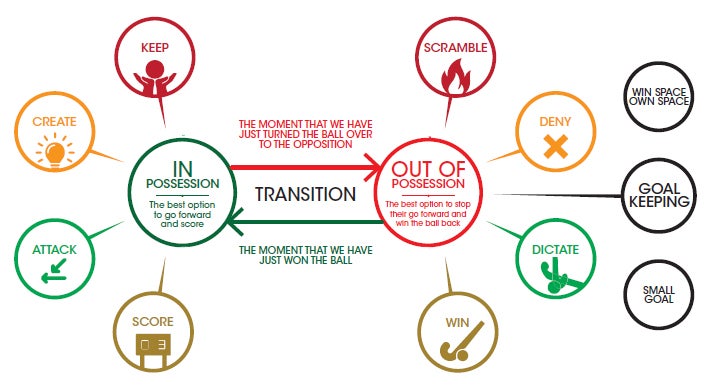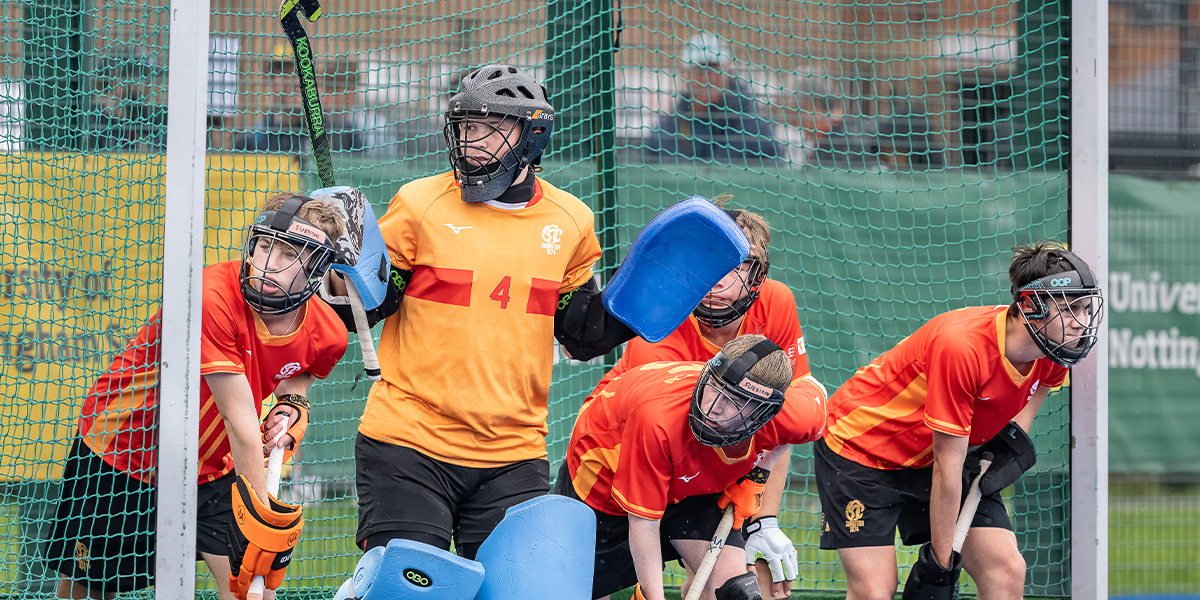Hockey is a multi-directional, multi-faceted game that requires AWARENESS of many different aspects. All of this has to be processed (often unconsciously) to enable appropriate action. The picture is constantly changing and as such, decisions have to be made, changed and continually assessed and reassessed.
The different aspects to be AWARE:
- PRINCIPLES AND PHASES OF THE GAME
- STRUCTURE
- TACTICS
- GAME CONTEXT
These four aspects of AWARENESS will all influence the decision to act and are all classified under GAME UNDERSTANDING.

Game Understanding is important for both field players and goalkeepers. A goalkeeper is not always close to the action, but it is important that they immerse themselves in all aspects of game understanding. Out of possession is more obvious as this will ultimately lead to their action. But, they can learn about, influence and impact aspects of in-possession. With good awareness and game intellect, they can be the eyes and ears for their team.
It is important that GK and field players alike have time to work together to encourage communication and collaboration in problem-solving in regards to their game understanding.
-
IN POSSESSION - In possession is any moment within the game when our team have possession of the ball.
Main Principle - The best option to go forward and score.
Keep Phase - Opposition have the advantage. We must retain possession of the ball
Create Phase - Neutral position important to find the best way to go forward
Attack Phase - We have the advantage to go forward at speed
Score Phase - We are inside the circle. Our intention is to get an outcome (PCA; shot on target; rebound or goal).
Transition Out of Possession - The moment that we have lost possession to the opposition – we should also have principles that anticipate losing the ball. So during our attack or score phase, there are some members of the team planning and thinking about ‘what if – we lose the ball’ commonly known as “counter control”.

OUT OF POSSESSION - Out of possession is any moment within the game when the opposition have possession of the ball.
Main Principle - The best option to stop their go forward and win the ball back
Scramble Phase - Opposition have the advantage to go forward. Our intent is to limit their opportunity to go forward at speed
Deny Phase - Stop their go forward by denying time and space
Dictate Phase - Force the opposition into an advantageous position for us
Win Phase - We have created an opportunity to WIN the ball back.
Transition into Possession - The moment that we have won possession from the opposition – we should also have principles that anticipate us winning the ball. During a ‘win it’ phase, we could organise some members of our team to already start moving into positions that help us attack with pace ‘what if – we win the ball?’
Due to the specific nature of goal-keeping there are two principles of game understanding that they would need to consider specific to their positioning:
‘Win space’-’Own space’ principle – the way that we as GKs maintain control of the space between GK and striker.
Small Goal Principle – the way that a GK can control their depth and angles with their defenders and stance to reduce the size of the goal that a striker has to shoot at.
(The traffic light system red, amber, green with an addition of gold is there to assist in the brain linking decision making moments. Red being a really tricky situation; amber being a warning or a get ready; green being a moment to capitilaise on the advantage and gold being the key moments to go in our favour.)
-
The structure of a team is the shape we want to create in order to utilise the strengths of our team. This could be 3-2-3-2 or 4-3-3 or 4-2-2-2 there are many different structures that could be identified but the important question is...why?
- Why is this shape good for this team and does the shape need to change in possession to out of possession and if so how are you going to change shape. Which positions will alter?
- What are your team and individual strengths? Does your strucutre in possession and out of possession optimise the use of these strengths?
- If your team understand the basic structure can you establish dynamic connected movement amongst your players to constantly replace the same structure?
- Does your team understand the benefit of a different structure?
- Can they change shape and understand what the different shape brings to the team? And how it might impact the opposition?
There is further information and supporting videos on the HOCKEY HUB about different structures and how and why you might choose one structure over another
-
Tactics are carefully planned strategies to achieve a desired outcome.
Where on the field are we trying to win the ball when the opposition have an outlet?
How might we be looking to change and adapt our structure to play against a specific opposition to mitigate their strengths or capitalise on their weaknesses?
Tactics can be pre-planned or can be altered mid-game. They are often coach-driven, although giving players ability to problem solve on the field can be really beneficial to a team’s outcome. One of the most simple tactics to implement, and important to understand, are the pros and cons of playing and playing against: Man 2 Man or Zonal
There is a section on Hockey Hub that looks into out-of-possession play - playing a Man 2 Man and a Zonal defence and in possession play playing against a Man 2 Man or a Zonal defence and how that may change your tactics.
IN POSSESSION
- Shape change from deep outlet
- High Line High Transfer shape change
- Circle Free Hits and Long Corners – set moves
- Playing against Zonal or Man 2 Man
- Opposition have specific strengths out of possession (individuals or team)
OUT OF POSSESSION
- Man 2 Man or Zonal defence
- Pressing trap – where do we want to dictate the play?
- Pressing shape – structure
- Deep defence decisions
- Opposition have specific strengths in possession (individuals or team)
-
In any one moment of a game a different context can be playing out.
For example a player playing as a forward with 1 minute left on the clock winning 1-0 may decide to take the ball towards the attacking right corner to keep possession to ensure their team a win. With 1 minute to go but losing 1-0, they may decide to take on the 1v1 along the baseline to make a circle entry. The context of the game has adapted their decision making on the field.
Different contexts that might occur during a game/tournament of hockey:
- How long left on the clock
- Score
- Location on field
- Strength of opponent
- Location within the circle
- Number of players on the field
- Importance of match (i.e. is it developmental or must-win)
Of course, there could be a number of these contexts playing out at the same time e.g. you are 1-0 up with 3 minutes to go, with a player in the sin bin.
Players and coaches can work on these different elements in training sessions. ‘What if’ scenarios / training sessions are a great way of getting players and coaches to problem-solve and reherse, so when they occur in a match, there is common understanding about what to do.





